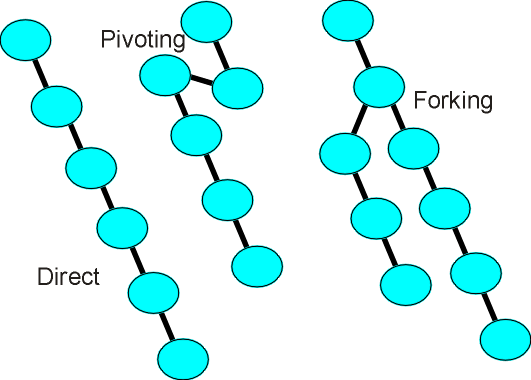
Prepositional chains can provide a high degree of specificity, establishing a context within the scope of one sentence. The chain can switch around as it describes relations, so we can have
Noun phrase of an attribute of an attribute of an attribute
An attribute of an object with an attribute of a location
This is similar to the noun phrase's ability to switch around, as
the red fox
the machine shaft
where
A can be an attribute of B
B can be a component of A
A can be the subject and B the object of a relation - the company employee
A can be the object and B the subject of a relation - the building owner
but a prepositional chain offers more scope for pivoting along its length, with six elements in the chain being not uncommon in legal documents or scientific abstracts, where the author is usually scrabbling to provide sufficient context. When mixed with participials and coordinate and comma phrases, more than twenty objects in the chain are possible.

There will usually be forking in the chain - it will be rare where the chain is composed of direct links. There is heavy reliance on knowing how the objects described in the noun phrases fit together as a means of unravelling the chain.
If any element in the chain can be matched uniquely, it is possible to extend out from there to an increasingly complex object which can be matched uniquely in the structure. Alternatively, a more complex object can be assembled using the attributes and components in the chain, until an object sufficiently complex to match uniquely has been constructed. The method is heavily dependent on the method used to unpack noun phrases - See Unpacking Noun Phrases.
There are a number of rules in handling what is visible in a chain - sheathing is one of them. That is, if an object in the chain jumps over elements of the chain in finding its left target, the elements jumped over can no longer be seen by elements to the right of the object (it is implicit in the tree diagrams people draw to show the output of a parser, but needs to be understood when working out the connections).
Some chains have following structure, resulting from some verbs tolerating a preposition and participial clause. An example
I object to the neighbour using a leafblower.
In longer form
I object to the use of a leafblower by the neighbour.
The objection is to the use, so the NounPhrase PresentParticipial NounPhrase form will be dubbed a ParticipialClause. There is only a limited number of verbs that support this form. Another example
John benefits from Frank owning a house.
Or, in another form
(Frank owning a house) benefits John.
The "from" here reverses the connections of the "benefits" verb, making it unusual (for transitive verbs).
Long chains with twenty or so components become extremely unwieldy. It is better to break them up if possible using sheathing as a basis. Potential sites are
| Coordinate phrase - and, or | |
| Infinitive phrase | |
| Interim noun phrase | |
| Relative pronoun clause |
Each of these possibilities is explored as the chain forms. For example
Tenant shall lease the Premises on .............(50 words)..................to be occupied............
The "to be occupied" refers to the Premises, but there are eleven other possible targets in the preceding chain components (most of which will immediately fail as objects of ToOccupy). When the infinitive is detected, it checks that the symbols in the preceding chain are available for analysis and then checks for the most likely target. If it can bound the chain to its left, it does so and that part of the chain will collapse to a single element, no longer able to be seen by chain components to the right of the infinitive (the objects are sheathed). To be most effective, the infinitive may need to resolve its subject or object first, so
"to be occupied by Tenant"
The Tenant can occupy a limited subset of things, while the "to be occupied" relation by itself allows a larger subset.

Note the appearance of Object Groups to handle the coalescence of objects or relations and the sheathing provided by long jumps.
See Prepositional Chains - a presentation
Prepositional Chains and Recursion